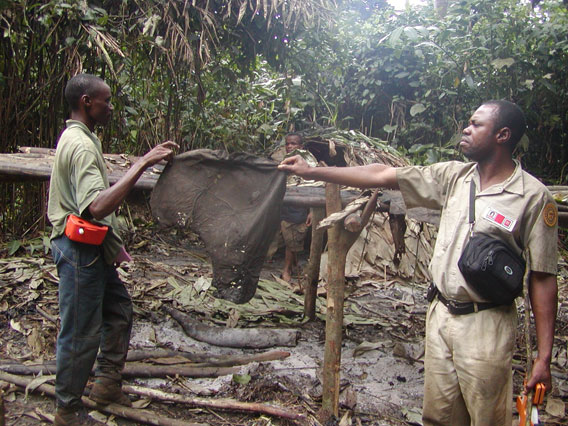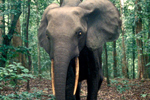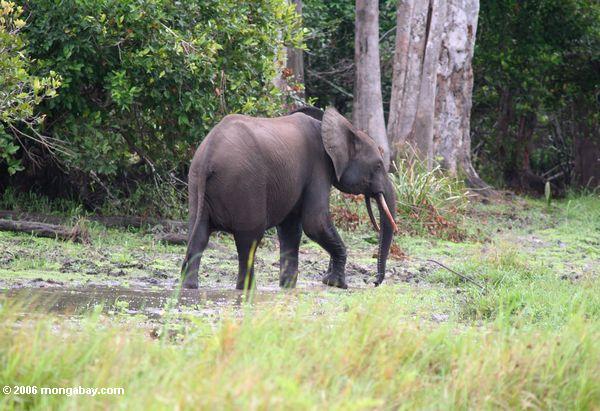A forest elephant in Gabon. Photo by: Rhett A. Butler .
Warfare and poaching have decimated forest elephant populations across their range with even elephants in remote protected areas cut down finds a new study in PLoS ONE. Surveying forest elephant populations in the Okapi Faunal Reserve in the Democratic Republic of Congo, researchers have found that the population has fallen by half—from 6,439 to 3,288—over the past decade in the park.
“Having protected areas is not enough to save elephants in times of conflict,” says lead author Rene Beyers, a postdoctoral fellow at UBC’s Department of Zoology. “The war in the Democratic Republic of Congo had a large impact on elephant populations, including those in parks and reserves.”
The study found that forest elephant faced the steepest declines on the park’s edges and in areas where human infiltrated, and “after the war, elephant densities were relatively higher in the center of the park where they were better protected, suggesting that this area may have acted as a refuge,” the authors write.
Even though the civil was has passed, conflict persists in some places. In addition, forest elephants are still targeted for the black market ivory trade and bushmeat.
“We’ve found that two factors in conservation efforts were particularly effective: a continued presence by a highly committed government field staff and continued support by international organizations—such as the Wildlife Conservation Society, Gilman International Conservation and UNESCO—made a difference for their survival,” explains Beyers. The authors estimate that forest elephant populations in eastern Congo have fallen from 22,000 prior to the civil war in the mid-90s to around just 6,000 today.
Forest elephants (Loxodonta cyclotis), those inhabiting the Congo basin, have long been considered a subspecies of Africa’s more well-known savannah elephant, however a number of recent studies have argued that forest elephants are in fact a distinct species. A recent DNA study found that forest elephants were as distinct from savannah elephants as Asian elephants are from the extinct mammoth.
“The divergence of the two species took place around the time of the divergence of the Asian elephant and woolly mammoths. The split between African savanna and forest elephants is almost as old as the split between humans and chimpanzees. This result amazed us all,” co-author Michi Hofreiter, who specializes in the study of ancient DNA in the Department of Biology at York, said at the time.
Forest elephants are generally smaller than their savannah cousins, and possess straighter tusks. Research has found that these species are vital seed dispersers for the forests of the Congo, playing an ecological role in the forest that no other species may be able to fill.

A wildlife inventory team came across this elephant poachers’ camp in the forest where an ear of elephant was left on a drying rack. Photo by: John Hart.
CITATION: Beyers RL, Hart JA, Sinclair ARE, Grossmann F, Klinkenberg B, et al. (2011) Resource Wars and Conflict Ivory: The Impact of Civil Conflict on Elephants in the Democratic Republic of Congo – The Case of the Okapi Reserve. PLoS ONE 6(11): e27129. doi:10.1371/journal.pone.0027129
Related articles
Unsung heroes: the life of a wildlife ranger in the Congo

(11/01/2011) The effort to save wildlife from destruction worldwide has many heroes. Some receive accolades for their work, but others live in obscurity, doing good—sometimes even dangerous—work everyday with little recognition. These are not scientists or big-name conservationists, but wildlife rangers, NGO staff members, and low level officials. One of these conservation heroes is Bunda Bokitsi, chief guard of the Etate Patrol Post for Salonga National Park in the Democratic Republic of the Congo. In a nation known for a prolonged civil war, desperate poverty, and corruption—as well as an astounding natural heritage—Bunda Bokitsi works everyday to secure Salonga National Park from poachers, bushmeat hunters, and trappers.
Over 80 percent of urban Congolese eat bushmeat
(06/27/2011) Bushmeat is one of the major threats to wildlife in parts of Africa: large and medium-sized animals are vanishing from regions in a trend dubbed by biologists the ’empty forest syndrome’. A number of popularly consumed species are also threatened with global extinction. A new study in mongabay.com’s open access journal Tropical Conservation Science surveyed 1,050 households in Brazzaville, the capital of Republic of the Congo, regarding their consumption of bushmeat only to find that the practice was practically universal: 88.3 percent of households in Brazzaville consumed bushmeat.
Elephants: the gardeners of Asia’s and Africa’s forests

(04/25/2011) It seems difficult to imagine elephants delicately tending a garden, but these pachyderms may well be the world’s weightiest horticulturalist. Elephants both in Asia and Africa eat abundant amounts of fruit when available; seeds pass through their guts, and after expelled—sometimes tens of miles down the trail—sprouts a new plant if conditions are right. This process is known by ecologists as ‘seed dispersal’, and scientists have long studied the ‘gardening’ capacities of monkeys, birds, bats, and rodents. Recently, however, researchers have begun to document the seed dispersal capacity of the world’s largest land animal, the elephant, proving that this species may be among the world’s most important tropical gardeners.
